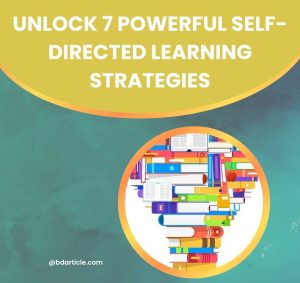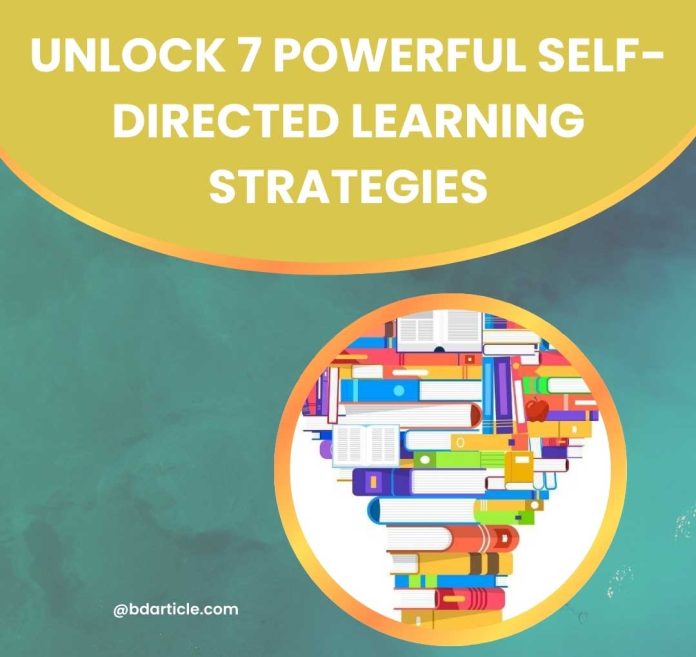Self-directed learning strategies are transformative methods that enable individuals to control their educational experiences fully. These strategies emphasize the importance of independence and initiative, empowering learners to design their paths based on personal interests and objectives. Whether you are a student striving for academic excellence, a professional enhancing your skills, or a lifelong learner pursuing personal growth, self-directed learning can revolutionize how you acquire knowledge and achieve goals.

At its core, self-directed learning is a process where individuals take the lead in identifying their educational needs, setting objectives, sourcing appropriate resources, and evaluating their progress. This approach contrasts sharply with traditional learning methods, often relying on structured guidance from educators or institutions. By embracing self-directed learning, individuals cultivate a sense of autonomy and responsibility, laying the groundwork for long-term success.
The Essence of Self-Directed Learning
One of the most significant benefits of self-directed learning is its ability to strengthen intellectual capabilities. Learners are encouraged to think critically, solve problems creatively, and engage deeply with the subject matter. By navigating challenges independently, they develop resilience and adaptability—qualities essential in both personal and professional spheres. Additionally, self-directed learning fosters a proactive mindset, inspiring individuals to seek growth opportunities rather than waiting for them to arise.
Adopting self-directed learning strategies is advantageous and essential in today’s fast-evolving world. This approach equips individuals with the skills and mindset needed to thrive in an era of continuous learning and innovation.
7 Powerful Self-Directed Learning Strategies
-
Set Clear and Achievable Goals
To maximize the benefits of self-directed learning, start by defining clear, measurable, and achievable goals. Break down your objectives into smaller milestones to maintain focus and track progress. For example, to master a new language, set weekly vocabulary targets and practice speaking daily.
-
Develop a Personalized Learning Plan
A personalized learning plan ensures your efforts align with your unique learning style and preferences. To diversify your approach, incorporate various self-directed learning activities like online courses, podcasts, and books. Tools like Trello or Notion can help organize your plan effectively.
-
Leverage Self-Assessment Techniques
Evaluating your progress is a cornerstone of self-directed learning. Use tools like quizzes, peer reviews, or reflective journals to assess your understanding and identify areas for improvement. For instance, online platforms like Khan Academy offer self-assessment features if you study mathematics.
-
Cultivate a Growth Mindset
A growth mindset—the belief that abilities can be developed through dedication and effort—is crucial for success in self-directed learning. Embrace challenges, view failures as learning opportunities, and celebrate progress to sustain motivation.
-
Utilize Resources Effectively
Accessing the right resources can make or break your learning experience. Explore both free and paid platforms to gather materials that suit your goals. For example, Coursera and Udemy offer diverse courses that support self-directed learning strategies in the classroom and beyond.
-
Engage in Collaborative Learning
While self-directed learning emphasizes independence, collaboration can enrich the process. Join online forums, study groups, or workshops to share ideas and gain diverse perspectives. Collaborative discussions can enhance your understanding of complex topics and provide real-world applications.
-
Master Time Management Skills
Effective time management ensures consistent progress in self-directed learning. Use techniques like the Pomodoro Method or time-blocking to allocate dedicated periods for study. Additionally, set aside time for breaks to recharge and avoid burnout.
Self-Directed Learning in Action
To better understand how these strategies work, consider these self-directed learning examples:
- Language Learning: Using apps like Duolingo to set daily goals and track progress.
- Skill Development: Enroll in coding boot camps to acquire programming skills.
- Academic Research: Conducting independent studies using resources from libraries or online databases.
These examples highlight the versatility of self-directed learning strategies and their applicability across various fields.
Self-Directed Learning Strategies in the Classroom
Incorporating self-directed learning strategies in the classroom transforms traditional education into an engaging, student-centered experience. Teachers can:
- Provide open-ended projects that encourage exploration.
- Integrate technology, such as learning management systems, to facilitate self-paced study.
- Please encourage students to set personal learning goals and reflect on their achievements.
Such approaches help students develop autonomy, preparing them for lifelong learning.
The Theory Behind Self-Directed Learning
Self-directed learning theory is rooted in the idea that individuals learn best when they take initiative. Malcolm Knowles, a prominent educator, identified key components of self-directed learning:
- Readiness to Learn: The motivation to acquire knowledge.
- Self-Direction: The ability to plan and execute learning activities.
- Critical Reflection: Assessing the effectiveness of learning strategies.
These principles underscore the importance of empowering learners to take ownership of their education.
Engaging Activities for Self-Directed Learners
To implement self-directed learning effectively, engage in activities stimulating curiosity and creativity. Examples include:
- Project-Based Learning: Solve real-world problems through research and innovation.
- Mind Mapping: Visualize complex concepts to enhance understanding.
- Skill Challenges: Participate in competitions or challenges to test your expertise.
Remember, “Master Emotional Intelligence with Engaging Activities” to build the intellectual and emotional skills essential for holistic growth.
Conclusion
Self-directed learning strategies empower you to control your education and unlock your potential fully. Setting clear, achievable objectives allows you to maintain focus and chart a meaningful path toward your goals. Leveraging diverse resources such as online courses, books, and collaborative platforms enriches your learning experience while engaging in purposeful activities ensures your efforts remain impactful and aligned with your aspirations.
These strategies are not limited to independent learning; they are equally valuable in classroom settings, where they promote student autonomy and active participation. By embracing self-directed learning, you foster a mindset of curiosity, adaptability, and resilience—essential qualities for navigating the ever-evolving demands of the modern world. Ultimately, this approach cultivates a lifelong love for learning, empowering you to grow personally and professionally while continuously expanding your horizons.
External Resources for Self-Directed Learning
To deepen your understanding, explore these resources:
- Coursera – Offers comprehensive online courses across various domains.
- Edutopia – Provides insights into innovative teaching and learning strategies.
These platforms can serve as valuable starting points for your self-directed learning journey.
#Self_directed_learning_strategies #Self_directed_learning_examples #Self_directed_learning_activities

